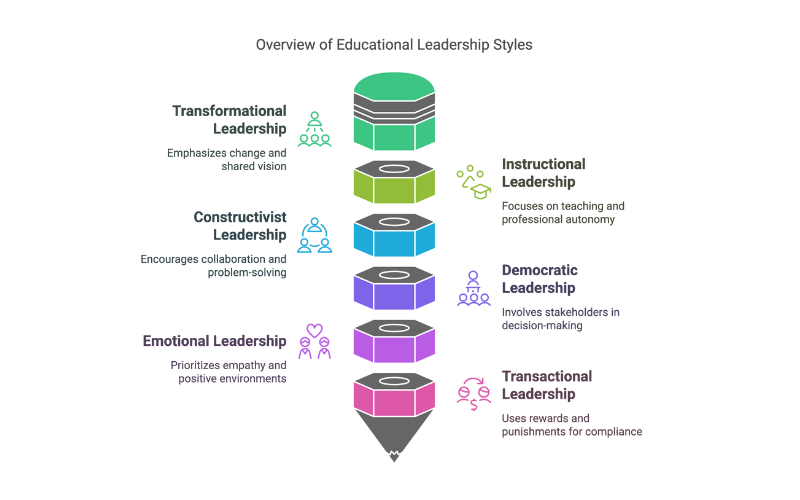
What are the different leadership styles in education, and how do they impact schools? This article explores various leadership styles used in educational settings and examines their effects on school culture and student outcomes. Understanding these styles can help educational leaders create a positive learning environment and address the unique needs of their schools.
Key Takeaways
- Educational leadership is focused on empowering individuals, enhancing student learning, and fostering a collaborative school culture.
- Understanding various leadership styles, such as transformational, instructional, and democratic, enables leaders to tailor their approach to meet the unique needs of their schools.
- Effective leadership in education significantly impacts student outcomes, making it essential for leaders to continuously adapt their styles to changing circumstances and the needs of their teams.
Understanding Educational Leadership

Educational leadership is distinct from other types of leadership due to its focus on creating a vision and building a path to achieve it. Key positions such as principals, deans, superintendents, and teachers play vital roles as an educational leader in shaping school culture. Unlike business leadership, which often prioritizes financial outcomes, educational leadership centers on people and their development. This people-first approach helps both students and teachers feel valued and supported in their endeavors.
Forward-thinking and adaptive, effective leaders in education empower others, creating a ripple effect of leadership within the school. The primary goal of educational leadership is to enhance student learning while improving the overall atmosphere of the school. This involves fostering a collaborative school culture where challenges related to underperformance are overcome, and a spirit of risk-taking and innovation is encouraged.
Understanding different leadership styles helps educational leaders create a personalized leadership identity. This knowledge allows them to tailor their approach to meet the specific needs of their school, contributing to safer learning environments and effective learning solutions that benefit both students and staff. The ultimate aim is to help teachers and students perform at their best by cultivating a culture of collaboration and mutual support.
Common Leadership Styles in Education

In the realm of educational leadership, several educational leadership styles have emerged as particularly effective. These include:
- Transformational leadership
- Instructional leadership
- Constructivist leadership
- Democratic leadership
- Emotional leadership
- Transactional leadership
Each style brings a unique approach to managing schools and influencing student outcomes.
While there is no single best style, understanding the various options allows educational leaders to adapt their methods to suit their strengths and the needs of their school.
Transformational Leadership Style

Transformational leadership in education emphasizes change, innovation, shared vision, and motivation. A transformational leader aims to transform their organizations through enthusiasm, energy, and a strong vision. They focus on encouraging, developing skills, and empowering both teachers and students. By responding positively to teachers’ pro-social behavior, transformational leaders foster a supportive and collaborative environment.
A key goal for transformational leaders is to communicate and sell their vision effectively to others. They strive to help their employees succeed and develop their potential. Although the relationship between transformational leadership and teachers’ emotional behavior is not statistically significant, the overall impact on school culture and student outcomes can be profound.
Transformational leadership creates an atmosphere of enthusiasm and shared purpose, driving both academic and personal growth.
Instructional Leadership Style
Instructional leadership style is highly perceived among school principals, focusing primarily on direct teaching and the development of learners. Instructional leaders do not micromanage teachers; instead, they trust their abilities and foster an environment of professional autonomy. This trust earns them respect and promotes a collaborative atmosphere within the school, reflecting an authoritative leadership style and an educational leadership style.
Strengthening teachers’ understanding of pedagogy allows instructional leaders to enhance instructional effectiveness and create positive learning environments. This leadership style highlights the importance of professional development and continuous improvement in teaching practices, ultimately benefiting student learning outcomes.
Constructivist Leadership Style
Constructivist leadership emphasizes collaboration, critical thinking, and problem-solving among teachers and students. Constructivist leaders encourage teamwork and innovative solutions, fostering an environment where creativity and adaptability thrive.
Promoting collaboration among teachers to find solutions enables constructivist leaders to create a dynamic and engaging educational environment. This approach not only enhances the learning experience for students but also supports teachers in developing new and effective teaching strategies.
Democratic Leadership Style
Democratic leadership, also known as participative leadership, emphasizes collaboration and the involvement of teachers and students in the decision-making process. This leadership style fosters a sense of ownership and participation among educators and students.
Democratic leaders enhance participation by valuing input from teachers and students, ensuring that all voices are heard and considered. Involving teachers and staff in decision-making and seeking feedback for improving school policies and practices enables democratic leaders to build trust and encourage a positive school culture.
Emotional Leadership Style
Emotional leadership, also known as affiliative leadership, focuses on empathy and understanding to create positive learning environments. This leadership style fosters safe bonds between students and teachers, promoting open dialogue and mutual respect.
While emotional leadership can be very effective in creating a supportive school culture, it often needs to be combined with other leadership styles to address all aspects of school management and student outcomes. The emphasis on empathy and emotional well-being contributes to a nurturing and inclusive educational environment.
Transactional Leadership Style
Transactional leadership is characterized by a traditional approach that emphasizes rewards for compliance among educators and students. This leadership style focuses on achieving specific outcomes by managing behavior through a structured system of rewards and punishments.
Transactional leaders utilize clear structures and requirements to guide behavior in educational environments. Success is often measured through the rewards given to students and teachers for meeting predetermined objectives.
While this style can be effective in maintaining order and achieving short-term goals, it may need to be complemented with other styles to foster long-term growth and innovation.
Impact of Leadership Styles on School Culture
Educational leaders play a vital role in shaping the norms and values that define a school’s culture. The leadership style adopted by a school leader sets the tone for the entire building, influencing every aspect of the school environment. From communication and collaboration to problem-solving and adherence to core values, leadership styles significantly impact school culture.
Promoting elements that facilitate progress and addressing those that hinder it enable leaders to enhance a positive school culture.
Creating Positive Learning Environments

Creating positive learning environments begins with a shared vision that involves everyone in the school community. Transformational leaders work directly with teams, focusing on this shared vision and ensuring that all opinions are heard and valued. Leaders set the tone for the school, creating a culture of respect, curiosity, and inclusivity.
Encouraging innovation and fostering dynamic learning environments help leaders enable both students and teachers to thrive. Commitment to diversity and inclusion is also crucial, with policies that reflect equity and support both academic and emotional needs. Ultimately, the goal is to ensure a safe, inclusive, and valued environment for all.
Setting High Expectations
High expectations are crucial for both students and teachers as they drive success. Effective school leaders maintain high expectations for every student to enhance their outcomes. Setting and communicating high expectations creates an environment where students are motivated to achieve their best, resulting in improved student achievement and growth.
Supporting Teacher Development

Instructional leadership emphasizes teacher empowerment and focuses on improving instructional quality for better student outcomes. Ensuring that teachers have ongoing professional development opportunities is essential for creating effective learning environments. Leaders should prioritize development that is tied to the specific challenges teachers face.
Effective educational leaders actively engage with teachers, understand their challenges, and offer specific solutions. This might include classroom visits, sharing feedback, collaborating on goals, and pairing teachers with mentors. Workshops on classroom management and technology tools can also help teachers engage their students more effectively.
Choosing the Right Leadership Style
Choosing a leadership style is vital for educators to align with their personal strengths and the specific needs of their learning environment. Aspiring educational leaders should focus on fine-tuning their leadership skills and deciding what type of leader they want to become.
Before selecting a leadership style, it is essential to assess the needs of the school environment and the behaviors and needs of teachers.
Factors to Consider
Educators must assess their own strengths and weaknesses when selecting a leadership style. The unique needs of the school environment are critical in choosing an effective leadership style.
Evaluating the specific challenges within the school helps in making an informed decision that aligns with both personal strengths and the needs of the school.
Adapting Leadership Styles
Educational leaders should continuously reassess their leadership approach to adapt to changing circumstances and feedback from their teams. Flexibility in leadership approaches allows educational leaders to address the varying needs of staff and students.
A flexible leadership style leads to improved educational outcomes by fostering a more responsive and engaging learning environment.
Benefits of Effective Leadership in Education
Strong leadership directly correlates with improved student learning outcomes. Research indicates that leadership in education is second only to classroom instruction in impacting student learning. Effective leadership styles can positively influence standardized test scores and other academic metrics.
An effective leadership style enhances the overall quality of education provided to students. Good leaders nurture environments where teachers feel supported and engaged. Different leadership styles can create positive learning environments that teachers thrive in. Effective leadership is crucial for managing classrooms, empowering students, and addressing emotional well-being.
Summary of Leadership Styles in Education
In summary, the choice of leadership style in education profoundly impacts student learning, teacher development, and overall school culture. By understanding and adapting various leadership styles, educational leaders can foster environments where both students and teachers thrive. Effective leadership is not static; it evolves with the needs of the school and its community. Aspiring leaders should continuously refine their leadership skills and remain flexible to address the ever-changing landscape of education.
Commonly Asked Questions
What is the primary focus of educational leadership?
The primary focus of educational leadership is to create a vision that enhances student learning and improves the overall school environment. This involves strategic planning and fostering a positive culture within educational institutions.
How do transformational leaders impact school culture?
Transformational leaders significantly enhance school culture by promoting change and innovation while cultivating a shared vision and motivation among staff and students. This approach creates a supportive and collaborative environment that inspires growth and engagement.
Why is instructional leadership important in schools?
Instructional leadership is crucial in schools as it focuses on improving teaching quality and fostering professional development, ultimately enhancing student learning outcomes. By emphasizing effective instruction, leaders can create an environment that supports both teachers and learners.
What leadership style works best in education?
The best leadership style in education often depends on the specific needs and context of the school environment. However, many educators find that a combination of transformational and instructional leadership styles can be particularly effective. Transformational leaders inspire and motivate educators and students by promoting a shared vision, while instructional leaders focus on improving teaching practices and academic outcomes. This blend fosters a positive school culture, enhances student learning,
What are the benefits of effective leadership in education?
Effective leadership in education significantly enhances student learning outcomes and fosters positive learning environments, while also improving teacher support and engagement. This ultimately contributes to a more successful educational experience for all involved.


